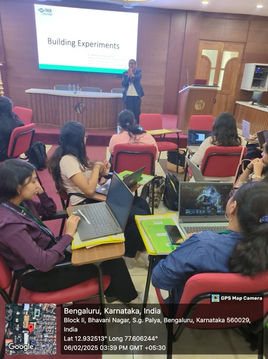Department of Psychology, CHRIST (Deemed to be University)

NeuroCognition Laboratory (NCL)
CHRIST (Deemed to be) University
School of Psychological Sciences
Summary Report- Eye Track 2025
3-Day Certificate Workshop on Eye Tracking Methodology
Overview
The three-day certificate workshop on Eye Tracking Methodology (EYE TRACK 2025) was held between 6th and 8th February, 2025 at CHRIST (Deemed to be) University, Central Campus, Bangalore. The workshop was organized by NeuroCognition Laboratory and there were 20 participants made up of post graduate students, PhD scholars and professionals from various disciplines. The workshop provided hands-on experience with state of the art eye trackers by Tobii and SR research, and participants also learnt how to design and conduct experimental research using Eye Tracking Methodology. The summary of the workshop sessions have been provided below.
The workshop was supported by volunteers from the 'Bridging the Future' program at CHRIST, which is a collaborative program between the Centre for Social Action at CHRIST and BOSCH India. The program focuses on empowering youths from underprivileged and economically disadvantaged backgrounds to gain training on various areas to improve their employability. The workshop also aligned with the Goal 12 of the Sustainable Development Goals (SDG), and efforts were made to reduce plastic waste during the event.


General Information
-
Type of activity- Workshop
-
Title of activity- 3-day Certificate Workshop on Eye tracking methodology (EYE TRACK 2025)
-
Dates- 6th, 7th and 8th February, 2025
-
Time- 8:45AM-5:00PM (6th Feb), 9:00AM-5:00PM (7th Feb), 9:00AM-3:00PM (8th Feb)
-
Venue- NeuroCognition Laboratory & Assembly Hall, Third Floor, Block 2, CHRIST Central Campus, Bangalore.
-
Collaborators/Sponsors- None
-
Program Schedule- View Full Schedule
-
Speakers & Organizers- View Full List



Day 1 (6th February- Thursday)
Session 1- Inauguration & Welcome (8:30-9:45AM)
Session 2- Neural & Theoretical Background of Eye Movement Studies [Lecture] (9:45-10:30AM)
Summary
In the first talk of the workshop, Dr Madhavi provided an overview of the history, principles, and methods of eye tracking, explaining its evolution over the years. She discussed the neuroanatomy of the eye, and how eye trackers offer insights into cognitive processes and their real-world applications. She talked about various types of eye movements and their significance in studying cognition. She briefly discussed various eye trackers used in research, highlighting their merits and limitations. The session concluded with an interactive discussion, providing participants with a strong foundation for the workshop.
Session 3- Studying Cognition with Eye Tracking [Talk] (10:45-11:30AM)
Summary
Mr. Varghese began the session with an interactive activity where participants had to clap upon seeing a face on the screen. He discussed the applications of eye tracking in studying cognitive processes such as attention, decision-making, and emotion recognition. Emphasizing the significance of human faces as stimuli, he explored their use in research across fields like developmental psychology, social psychology, clinical psychology, forensic psychology, and neuromarketing, supported by case studies. . The session concluded with a Q&A, addressing key terms in eye-tracking data interpretation and applications in sports psychology, website design, and other domains..
Session 4 & 5- Introduction to the Hardware and Its Operation [Talk & Hands-on Experience] (11:30AM-1:30PM)
Summary
This session introduced participants to various eye trackers through hands-on experience. They were divided into two groups, attending parallel sessions at different venues. In the Assembly Hall, Mr. Parag demonstrated the TOBII eye trackers, specifically Tobii Glasses and the Tobii Screen-Based Eye Tracker, explaining their applications in neuromarketing and behavioral neuroscience. Meanwhile, at the NeuroCognition Laboratory, participants were introduced to the EyeLink 1000 Plus from SR Research. These sessions provided real-time exposure to hardware setup, experiment execution, and eye-tracking data collection, enhancing participants' practical understanding of eye-tracking technology.
Session 6- Overview of Articles & Workshop Materials [Information session] (2:30-3:30PM)
Session 7- Building Experiments- Theory and Process [Talk] (3:30-5:30PM)
Summary
The session aimed to introduce the theory and process of building an eye-tracking experiment. During the first half of the session, the speaker explained the relationship between scientific theory, framing the research question, and designing and aligning the design to the specific eye tracking methods. In the second part of the session, Mr Adhiraj, focused on introducing participants to the process of programming the eye-tracking experiment. He provided a brief overview of the experiment builder software interface used for designing experiments for EyeLink 1000 plus eye tracker. He also covered key steps in experimental design and stimulus selection, using the Antisaccade task as an example.















